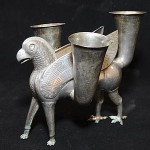When US Immigration and Customs Enforcement (ICE) finds stolen and illegally exported antiquities in New York, the confiscated goods end up in a nondescript warehouse in Queens. There they stay in climate controlled comfort while cases wind their way through the court systems or they can be returned to their countries and institutions of origin. The process can take years.
Obviously ICE doesn’t divulge the location of its warehouses, but they recently gave the New York Post a rare peek inside the Queens facility. The reporters weren’t allowed take pictures and of course they can’t print where it is, but it’s still some Indiana Jones awesomeness to get to see where so many goodies are kept. There are over 2,500 artifacts in the warehouse right now.
Fishy-looking shipments may catch the eye of customs officers who look for phony countries of origin such as Babylon or suspiciously low values declared on packages.
Tipsters also alert [James McAndrew, the ICE senior special agent in charge of cultural property,] about particular shipments or smugglers. In one case, officials in India told him to watch for artifacts mislabeled as lawn furniture.
When a crate marked “garden table sets” arrived by ship in Newark, customs officers called McAndrew, who raced to the port along with a top official with India’s Consulate General in New York.
The crate was opened to reveal hundreds of statues of Indian deities looted from temples and private homes. McAndrew said he had a sense of satisfaction mixed with dismay. “At least call it trinkets,” he said. “It was such a blatant ruse.”
The 600 or so pieces, some dating to the 4th century, have been stored at the Queens warehouse for three years as an investigation went forward.
 The most notorious piece mentioned in the article is a 7th c. Iranian silver griffin-shaped rhyton (ceremonial drinking vessel). Widely considered the premier griffin of antiquity, it was looted from Kalmakarra Cave, known as the Western Cave, in the western highlands of Iran between 1989 and 1992 along with untold other treasures. Over the next decade, bits and bobs of the reputed treasure turned up in various museums and markets around the world.
The most notorious piece mentioned in the article is a 7th c. Iranian silver griffin-shaped rhyton (ceremonial drinking vessel). Widely considered the premier griffin of antiquity, it was looted from Kalmakarra Cave, known as the Western Cave, in the western highlands of Iran between 1989 and 1992 along with untold other treasures. Over the next decade, bits and bobs of the reputed treasure turned up in various museums and markets around the world.
In 2000, the rhyton was hand-carried into the United States by art dealer Hicham Aboutaam of Phoenix Ancient Art. He described it in customs forms as Syrian, but that was a deliberate and knowing lie. When he sold it to a private collector in Manhattan for $950,000, the collector demanded guarantees of its authenticity, so Aboutaam actually brazenly got 3 expert reports confirming that it was part of the Western Cave treasure.
The sale took 2 years to go through, and 2 years later, after an ICE investigation Aboutaam was arrested for illegally importing the rhyton. Sadly, he just got a slap on the wrist. He pled guilty to falsifying a commercial invoice, paid a $5,000 fine and is still happily in business to this day, still dirty as the day is long. Just last year he and his equally dirty brother Ali “voluntarily” returned an astonishing 251 antiquities for a total estimated worth of $2.7 million to Italy. I put that “voluntarily” in quotes because you can bet your sweet patoo that the Italians threatened them with legal action to get them to cough up.
Meanwhile, the poor rhyton remains in that warehouse in Queens until relations between the US and Iran are normalized, which could be a long ways away.